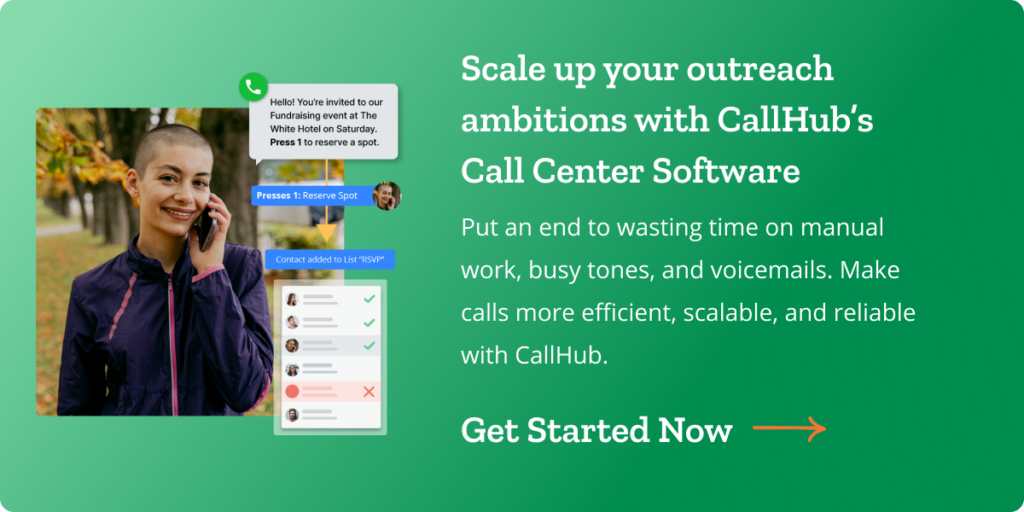Only 2% of sales occur during the first call to a contact. This means that a follow-up sales call is not just a good-to-have practice but a necessity to take advantage of the rest of the business.
But follow-up calls aren’t the easiest, are they? Challenges include:
- Call hesitancy: Agents feel nervous and dread talking to clients who may or may not want to speak with them.
- Not finding the right tools: Using tools that do not support or uplift the campaign you are trying to run.
- What to say: Agents are not entirely equipped with answers or responses when conversations move in different directions.
We’ve addressed the first two problems in these articles:
- Call Hesitancy: We’ve Collated Cold Calling Tips For Mind-Blowing Results
- Finding the right tools: A Complete Call Center Software Buyer’s Guide
This article explores the answer to the third. We explore how you can build an excellent follow-up sales call pitch to maximize conversions.
First, let’s look at best practices for an impressive follow-up sales call pitch.
Follow-up sales call best practices
We’ve collated best practices for a follow-up sales call pitch that forms the basis of a great campaign. Implementing these six best practices can improve the quality of your campaign:
- Use an excellent calling tool
- Reach out within 24 hours
- Schedule follow-ups
- Ensure you add value to the prospect
- Let them expect your next outreach
- Use multiple channels of communication.
Let’s explore them in detail.
Use an excellent calling tool
An excellent calling tool (read CallHub) will ease your process and make follow-up easier. Here are some–
- Save notes: With CallHub’s power dialer at your first point of contact, you can make 10x more calls than a manual dialer. But that’s not where the benefits end. A power dialer will allow you time to enter notes about a call and move on to the next. This way, even if different agents reach out to one contact, they are all updated about a contact’s history.
- Text from call center: Texting from the call center is one of the best features since you can immediately follow up with a prospect after a call. If a contact does not pick up your call, you can also drop a text reminder
- There’s no better feature than text from the call center regarding follow-up. You can use the same number to call and text contacts, making your call more recognizable. You can share links or more information about your conversation and get a higher response rate.
- Workflows: You cannot manually keep up with follow-up schedules for hundreds of contacts. What if your calling tool takes care of it for you? You can automate your follow-up process using workflows. Workflows help you create a schedule for each contact point. You can determine when a message goes out to your contact after a call, what happens if they open your text, or you can schedule an email to go out with more information.
Want to know more features that can help your calling and follow-up campaigns? Reach out to us for a demo.


Reach out within 24 hours
Whether it is through text, email, or another call – you must reach out to a prospect within 24 hours after initial contact. This helps a contact remember your conversation throughout the day.
You can send a message thanking them for their time or share additional resources to support your conversation. You could also share an email with the next steps they can take. The more time passes between your first and second contact, the more likely they will delay making a decision.
Schedule your follow-ups.
Have a timeline ready for when a contact needs to be reached. Your timeline can look as follows:


Schedule these actions on your outreach tool to speed up the process and ensure you get all the contacts.
| Want to create a follow-up schedule you do not need to work on actively? Try Workflow Automation on CallHub. You can automate multi-channel communications such as text, calls, and emails with workflows. Now, you can handle repetitive tasks swiftly. |
Ensure you add value.
Imagine receiving several calls from someone which amounts to nothing for you. You don’t learn more about what they are trying to sell, nor do they communicate how they can help you specifically. It is not a call you will be inclined to pick up repeatedly.
Adding value to each point of contact with a potential customer is essential if you want them to be responsive. You can share resources, tell them about previous customer experiences or perhaps recount how someone similar to them benefitted from your offering. Here’s something you can say:
“Hey John, in the meantime, I’ve shared a text with a case study of a client who had a similar problem as yours. You might understand how we approached the issue.”
No matter what you accomplish on a call, ensure you end it by adding value to the potential customer. They may not buy immediately but may come back to you at a later date if they see value in you.
Let them expect your next outreach.
It takes six calls to win a sale. Your contact will need to expect your call more times than once.
Before you end any conversation, tell them when to expect you next. It ensures you do not mirror the worst aspect of a cold call – catching a contact when they expect you least.
Tell them they may expect a call, text, or email from you. If your follow-up is planned and scheduled, tell them when to expect it and stick to it. Ensure you follow this schedule unless you want a customer to think you do not deliver on promises. Here’s what you can say:
“I’ll be happy to send you an email with the proposal details by next Tuesday afternoon. I’ll give you a call shortly after. How does that sound?”
Use multiple channels of communication.
Find out different ways in which you can reach out to a customer. You can collect their email ID or get them to opt-in to your message services while on call. Use this information to reach out to them through their preferred communication channel.
Each channel has its advantage. While a call is a great way to build personal connections, a text message has a 98% chance of being read. On the other hand, emails serve as an excellent tool for sharing well-designed pitches with clear calls to action.
Now that you know the best practices for an effective follow-up sales call pitch, let’s review some effective scripts for your campaign. We’ve studied some of the most successful campaigns on CallHub to design these templates.
Follow-up sales call script templates
Linear script sample
Linear scripts are simple, easy scripts an agent can scroll through during a conversation with a potential client.
Campaign brief:
You are following up with contacts who have shown interest in your offering after a round of cold calling. You aim to get them to commit to a demo or prepare them for another follow-up round later.
Hi {first_name}, my name is {agent_name}. I’m calling you from {organization_name}. How have you been since our last conversation?
SURVEY QUESTION:
Did you find the time to go through {any resource or message you sent} that I sent?
- Yes
- No
- Don’t recall
If they say no/don’t recall:
Alright, I had shared some information about ______. But we can speak about it now.
If they say yes:
Great! Do you have any questions that I can answer for you today?
You mentioned in your last call that you were struggling with ____. We can help you with that. (list how your offering can help). We can walk you through the tool to show exactly how it works. Would you like me to set up a demo for you?
If yes: Alright, I’ve set up a demo for you with our sales team. Is there a time you prefer?
If no/not interested: Alright, thank you for your time. If you would like to use our services at a later date, can I go ahead and subscribe you to our SMS list? You will not receive any spam from our side.
CALL DISPOSITION:
- Interested
- Not interested
- Demo scheduled
End Call:
Great, thanks so much for your time, have a great day.
Notes:
<add notes>
P.S Call dispositions indicate the end results of a call. You can set call dispositions to “interested”, “maybe,” “not interested”, etc., depending on labels that make the most sense to your campaign.
Branching script sample
Branching scripts help agents follow a more complex script without endlessly scrolling to the right sections. Depending on their responses, the script directs agents to the next appropriate response or question in the script. Here’s how it works:


Campaign brief
You have previously spoken to this list of contacts a couple of times, and they seem interested in our offering. This is a follow-up call to understand where they stand in the sales funnel and direct them toward a decision.
Hi {first_name}, my name is {agent_name} from {organization_name}. I hope you are doing well today. {first_name}, how do you feel about opting for our product/service at this point?
{wait for response}
- Interested
- Not interested
- I have a few questions
If interested:
I’m so glad to hear that! As part of the next steps, I will connect you with one of our sales representatives. They will guide you through the best product plan for you. Feel free to ask them questions if you have any. Can they give you a call today at 4 pm?
If not interested:
That’s alright. We would love to have you onboard. Can I ask you a few short questions?
Survey
Q: Is there any particular hurdle that is keeping you from choosing us?
- Price
- Support
- Product quality
- Not the right time for me
Q: What did you want us to improve about our product?
- Price point
- Quality
- Addresses the issue
Q: Can we subscribe you to our newsletters, in case our future updates interest you?
- Yes
- No
I have a few questions.
Alright, please ask me, and I’ll be more than happy to answer.
Call Disposition: Add call disposition (interested, not interested, needs more clarity)
Notes:
<add notes>
Get an impressive calling tool
Support your follow-up efforts with an outreach tool that offers great features and is extremely simple to use. With CallHub, you can:
- Create branching scripts to help your agents.
- Automate your follow-up.
- Stay compliant with regulations.
- Use a multi-channel approach to move contacts down your conversion funnel.
Learn more about CallHub’s powerful tools with its 14-day free trial.
Featured Image Source: Andrea Piacquadio


